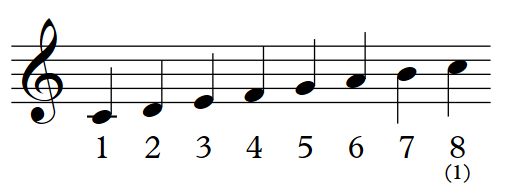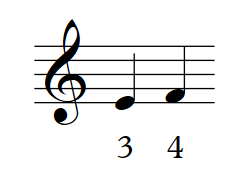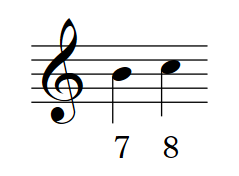Note that your final mark will not be saved in the system.
Intervals in a Scale Learn
Page: Position of Tones and Semitones in a Major Scale
Position of Tones and Semitones within a Scale
If we take any major scale and number each of the notes, it can help us to think about the patterns a scale contains without worrying about the notes.

This allows us to refer to each degree of the scale separately, which can be useful because each degree of the scale has the same job, regardless of which scale we are actually using at the time.
For example, the third degree of a scale determines the tonality (that is, whether the scale is major or minor). This is true of the third note in any scale, not just C major.
Now we can start to talk about numbers - and only 8 of them - rather than getting confused by which scale or key signature we are using.

Thinking back to our intervals, we can see that there are two semitones in between notes of our number scale.
The first is between notes 3 and 4.

The interval between each other pair of adjacent notes is a tone (remember a tone is the same as two semitones).

In a major scale, there are 5 pairs of notes which are a tone apart.
There are always 1 & 2, 2 & 3, 4 & 5, 5 & 6, and 6 & 7.
If we put the scale back together, we can see the pattern of tones and semitones which make up the scale.

Tones are indicated with a letter T
Semitones are indicated with a letter S
The best part is that this pattern can then be used to work out the notes of any major scale.
Let's pretend for a minute that we don't know about this pattern of tones and semitones, and try to play a scale starting on D.

If we only use the white notes, it's going to sound a little bit... strange. It's certainly not the D major scale we were hoping for.
Try playing it on your instrument.

Let's look at the pattern of tones and semitones between the notes we're playing.
Ah, the problem has become obvious. They're not in the correct pattern!

As a fun by-product of this exercise, we have explained why we have key signatures! They help to keep the notes in the correct pattern of tones and semitones for the scale we're using.
Or click 'Enter' key!